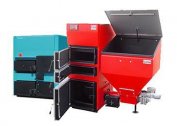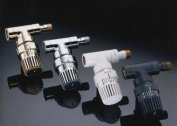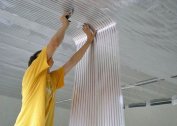Roof heating is important in areas where sharp temperature changes are characteristic. Due to a series of thaws and frosts, the roof and drainage system become icy, traffic jams form in the drain funnels, and the cornices are overgrown with icicles. This is traumatic and leads to the destruction and rapid wear of the roofing and drainage system.
Problem prevention
To avoid trouble, a heating system should be installed on the gutters and along the perimeter of the roof. The device starts automatically, when it is from minus 10 to plus 6 on the street, and maintains the desired temperature, preventing the formation of ice. Installation of the system does not affect the aesthetics of architecture. The installation is not visible from the ground.
Thanks to such equipment, the life of the roof and gutter, suffering from temperature extremes, is increased. Because of the ice, they become fragile, fade, become unusable fasteners, which leads to leaks. Heating solves all these problems.
De-icer Options
To heat the roof and drains, three types of de-icing systems are used: water, infrared and cable. Each has its pros and cons.
Water installations
On the surface of the roof or under it, pipes extend into which hot water is launched. It is heated with a home gas or electric boiler. But there are also combined with electrical installations, when the fluid in the pipes is heated due to the built-in wire.
The advantages of “liquid” heating of the roof and gutters from snow is that when using a gas boiler, the cost of maintenance is less. It also allows the system to operate when the power is off.
A water installation is stronger and more durable than electrical options. But it is more difficult to mount it: water pipes are thicker and less flexible, so it is more difficult to bend them. In addition, in cold weather, water cools, and pipes may burst. You need to start the system before the icing occurs, otherwise the work will not be effective.
Cable systems
Roof heating based on a heating cable is by far the most common. The kit includes a distribution network, a control unit and heating elements, fasteners.
Due to the control unit, temperature relays, an emergency shutdown toggle switch, as well as sensors measuring precipitation and temperature indicators on the street are monitored. When the situation becomes critical, the unit automatically starts heating.
It is carried out due to a special cable, which is fixed on the roof, gutters and pipe, cornice. Thanks to its flexibility, the heating wire can be located in the most inaccessible places, for example, to heat the roof or to prevent the appearance of ice on the ledge of the balcony.
Advantages of cable installation:
- work as necessary, and not constantly;
- increased protection against damage;
- long service life.
It is not easy to lay the cable with your own hands, it is better to contact a professional. In addition, electricity bills are increasing, and the installation will not work if there is a power outage.
Infrared varieties
It has not yet gained popularity in the territory of the Russian Federation, but in fact it is the most convenient option to heat the roof.The principle of operation is that electricity is transformed into infrared radiation, which naturally melts ice and snow. Heating is due to special elements made of carbon fiber, which are connected by silver-copper plates. They are located between the protective layers, which do not allow to lose heat and penetrate moisture into the system.
The advantages of the infrared heating system of the drainage system and roof include:
- maximum efficiency;
- uniform heat transfer;
- ease of installation;
- simplicity of temperature control;
- energy saving;
- long term of operation.
The infrared heating circuit can be installed in difficult places, except for drainpipes. The system is mounted under the roof surface.
Cable selection and power calculation
The heating wire is produced in two varieties. It can be resistive and self-regulating. The first type is more attractive and easier to install. It has a fixed linear power - heat transfer per “square” of roofing, so it is easier to calculate the required amount and power indicator for the entire area. For de-icing systems, wires are used that connect to a regular 220-volt network. Suitable power is 20W / m.
To calculate the total power indicator, you must:
- measure the lengths of all the gutters and reduce the data into a total amount;
- double this number, getting the length of the wire, which will be located along the perimeter of the roof;
- add to this number the total length of the drainpipes;
- multiply the amount by 25.
This will be the power indicator for the cable system in watts. If the cable runs elsewhere, these segments should also be taken into account in the calculation.
In de-icing systems, resistive wires with one or two cores are used. The first option is cheaper, but not functional. Current flows only along one “string” of metal, which leads to the need to connect a cable from both ends. They should be reduced to a control unit, which is not always convenient. It is impossible to divide the wire into segments. A two-core version due to a pair of metal wires inside the shell can actually be connected to the block at one end. The second, remaining on the roof, is closed by an airtight clutch. Such a heating element is more expensive, but installing it is much easier, especially if the roof is a complex configuration.
The heating cores of the resistive cable are protected by insulation, on top of it there is a copper braid, wrapped in a special sheath. This multilayer construction saves from overheating and freezing, moisture, damage. For hard roofing building materials: corrugated board, slate, tile, you can use the cores in any shell. The soft roof is heated with a fluoropolymer braided cable.
When installing a resistive cable, one must take into account that it cannot be bent much, otherwise the core inside will break. The distance between the turns should be 40-60 mm.
Self-regulating heating cable is better than resistive. It is more sensitive to temperature changes, capable of regulating heat transfer. In the shade it will bask more than in the sun, in hot weather - less than in cold. This provides high-quality frost prevention and savings - electricity does not go into the void.
Inside such a wire are copper conductors, a matrix regulating heat transfer, a protective sheath and a braid, and on top of it all is covered with another common sheath. However, there are difficulties with the calculation of power, so the design and installation should be entrusted to a specialist.
Mounting Features
 Before you install the heating system, you need to draw up a project and make an estimate. Only then can installation be started.At the same time, the wire is placed on special guides that are included in the system kit or are purchased separately in the building goods store.
Before you install the heating system, you need to draw up a project and make an estimate. Only then can installation be started.At the same time, the wire is placed on special guides that are included in the system kit or are purchased separately in the building goods store.
If the drainage system is not installed, install the cable as follows:
- On roofs with a small slope, installation is carried out using a special depression in the center.
- With a steep slope of the roof, the system is laid in the direction from the center to the edges. Near each corner, small holes are made to remove rainfall and cable loops.
In the presence of drainage elements, self-regulating cables are used. The wire is installed in several rows at the bottom of the pipe at least 2/3 of its length.
The selection of a suitable anti-icing system and its proper installation will contribute to the fact that in winter you will not suffer from ice and icicles, and the roof and drain will last much longer.







